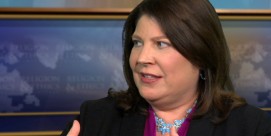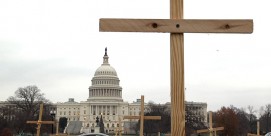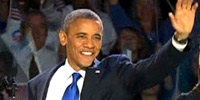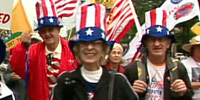FRED DE SAM LAZARO: Welcome, I’m Fred De Sam Lazaro, sitting in for Bob Abernethy. It’s good to have you with us for our annual look back at the top religion news stories of 2015. E.J. Dionne is here, he’s a senior fellow at the Brookings Institution in Washington, a columnist for the Washington Post, and a professor at Georgetown University. Jerome Socolovsky is the editor-in-chief of Religion News Service, and Kim Lawton is the managing editor of this program. As preparation for our discussion, Kim produced a survey of the major religion stories of this past year.
KIM LAWTON, correspondent: Terrorism and extremism continued to dominate headlines in 2015 as ISIS—and those inspired by ISIS—ramped up attacks and used their religious beliefs to justify their violence. Inside Syria and Iraq, ISIS continued its campaign of atrocities against religious minorities. Christians, Yazidis and Muslims who disagreed with ISIS’ interpretation of Islam were executed or taken hostage. Christian villages and historic archeological sites were destroyed. The world was shocked by terror attacks outside the region as well, including in Paris and here in the US. Numerous Muslim leaders across the globe strongly denounced the violence, calling it “despicable” and a perversion of the Islamic faith. Pope Francis said using the name of God to justify such brutality was “blasphemy.”

In the wake of the violence, many Muslim communities reported suffering a backlash. There was a sharp rise in threats and vandalism at mosques and Islamic centers. As the presidential campaign got underway, several GOP candidates were criticized for making anti-Muslim remarks. Donald Trump provoked international controversy with a call for “a total and complete shutdown of Muslims entering the United States.” Lawmakers debated whether to stop admitting Syrian and Iraqi refugees because of security concerns. At the same time, a wide range of religious leaders condemned the heightened anti-Muslim rhetoric. Many interfaith groups organized special events to express solidarity with Muslims. They also urged political leaders not to impose any new limits on refugees.
Meanwhile, the international refugee crisis continued unabated as record numbers of migrants from the Middle East and Africa made their way to Europe. European leaders struggled over how to deal with the hundreds of thousands of people who were fleeing persecution and poverty. Many migrants died trying to reach Europe by sea. Humanitarian groups expanded aid efforts but were unable to keep up with the needs.
Pope Francis continued shaking up the Catholic Church. His encyclical on the environment drew international attention for its condemnation of human activities that contribute to climate change. He stressed a moral obligation to address the crisis, and in particular, its impact on the poor. The encyclical encouraged many faith-based activists who lobbied governments and the United Nations to take new steps to curb climate change. The document generated controversy among some conservatives who were also upset by the pope’s criticism of capitalism. Francis stressed issues including climate change, immigration and poverty during his visit to the US, which received wall to wall media coverage. Francis also continued his agenda of reform inside the church, making changes to the Vatican bureaucracy and streamlining the annulment process.
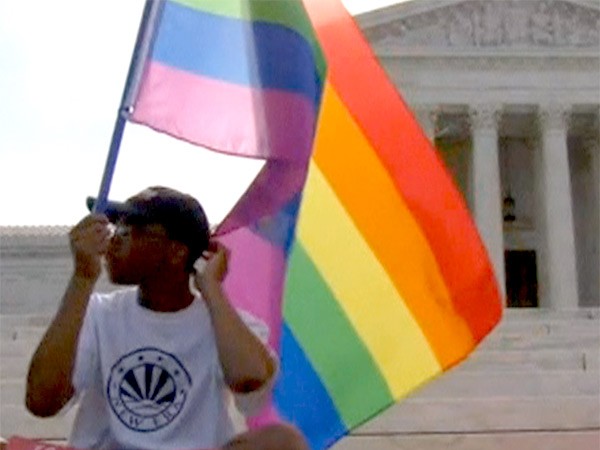
In the US, the Supreme Court issued a landmark decision legalizing same-sex marriage in all 50 states. Many faith leaders praised the decision as a move toward justice and equality. But others condemned the decision. The Southern Baptist Convention, the US Catholic bishops and the Mormons all reaffirmed their belief that marriage can only be between a man and a woman. Many gay marriage opponents said the decision has endangered their religious liberty. There were contentious debates over whether state officials could deny issuing marriage licenses to same-sex couples or business owners could deny services because of their religious beliefs about marriage.
In the wake of several mass shootings, religious groups were among those repeating concerns about gun violence in the US. Many renewed calls for more gun control laws. Nine people were killed during a mass shooting that took place at a Charleston, South Carolina church during a prayer meeting. Family members of the victims said they forgave the shooter. The incident set off a vigorous debate about the display of Confederate symbols.
The "Black Lives Matter" movement gained steam across the country with strong support from many religious groups. After several high-profile shootings by police officers, there were calls for reforms in law enforcement procedures, as well as calls for more dialogue about race issues.
The Episcopal Church elected its first African-American presiding bishop, Michael Curry, who pledged to make reconciliation a key priority.
In Los Angeles, Muslim women launched the first female-only American mosque. In contrast to traditional mosques, here women lead the prayers and preach the sermons. All the worshippers are female.
Surveys showed the number of Americans who do not affiliate with any particular religion continued rising to a record 23 percent. About seven in ten Americans do still identify with a religion. And many of those faith groups sought news ways to generate enthusiasm and reach out to their communities.
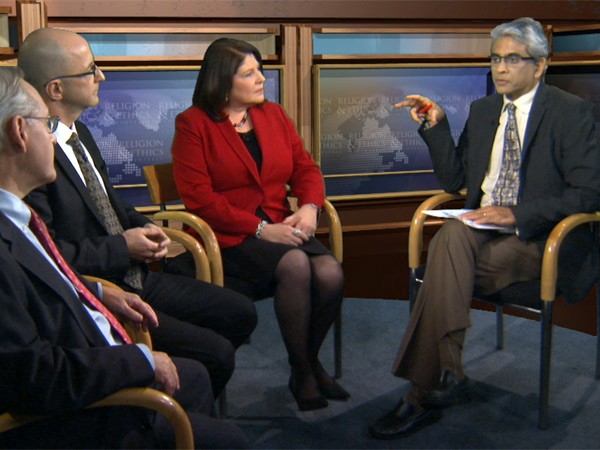
FRED DE SAM LAZARO: Thanks Kim. You know I was watching the piece you did for your earlier [Look Back] and it struck me how many of these issues are exactly the same. It could’ve been a repeat of the previous year except for 2015 it was more of the same, only on a worsening trajectory on so many of these looming issues. Is this anything that we could’ve expected?
KIM LAWTON: 2014 on steroids, sort of. It really was. We did talk a lot about many of these issues. The issues came closer. For example, last year we had a problem with the Syrian refugee crisis, but the refugees were in the Middle East. Now they’re in Europe and people are really panicked and now we’re talking about them coming here. So I really noticed that a lot of those issues seem closer to home. Some of the terrorism stuff is here again, and so I think that heightens everything. But yeah, there are some really big problems in the world that seem almost intractable sometimes.
JEROME SOCOLOVSKY: I think we got to know ISIS better in a way. We got to see how their jihad is a kind of apocalyptic struggle and they’re trying to draw the West into this end of times battle, and we got to see the medieval face of ISIS as well, with the iconoclastic attacks and destroying antiquities in museums and the ruins in Palmyra and Syria. So I think we’re learning more about them too.
DE SAM LAZARO: What did the proximity of ISIS in a sense do for the American psyche in the wake of Paris and then San Bernardino. Those links, however tenuous, you know, created an association I would imagine, or presence of this organization so much closer to us in United States.
E.J. DIONNE: First of all, Kim, congratulations on a superb piece, it was astonishing to realize how much actually happened this year. I think that Americans felt a kind of fear that they hadn’t felt in a long time. It’s not that ISIS is here, it’s that there was an attack which was linked to ISIS, and it was not done in an organized way by people coming in here. The fear of lone wolf attacks which are much harder to deal with is a fear we hadn’t really experienced since 9/11, and that was a different thing at the time. I also think you saw kind of bookend reactions to the refugee crisis, on the one hand Donald Trump’s reaction, saying we should shut our borders to Muslims, he says temporarily, which led, it should be said, to a great outcry within his own party as well as among Democrats. But at the other end of this continuum was Chancellor Angela Merkel, who was TIME Magazine’s person of the year, and I think she earned that simply by her, for myself, simply by her response to the refugee crisis. At some considerable political costs, and we still don’t know what that cost is going to be because there was a rebellion in her own party, she opened the doors of Germany to hundreds of thousands of refugees. The numbers could hit about a million. And you had also a lot of religious leaders in the United States making the point that yes we have to deal with security but we really have to be more openhearted than we have been to a lot of people who are the victims of ISIS and not the causes of these attacks.
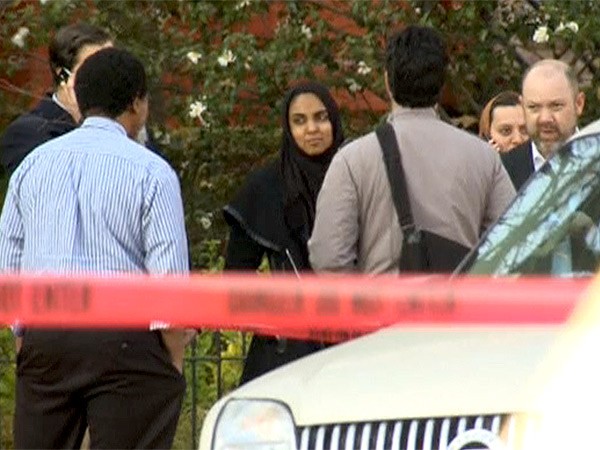
LAWTON: One thing that was really different this year from last year and many previous years was the level of, how that level of fear was then translated into a very strong suspicion of many in the Muslim community, and many Muslims say they’ve felt a greater level of threat than even after 9/11. And whether or not that’s true, but it’s that perception out there, this level of...people are aiming their concerns at the Muslim community. And that was something that troubled a lot of people in the faith community, and you saw a widespread backlash against the backlash so to speak, and so there were a lot of faith leaders speaking out, in a broad coalition, not just sort of the usual suspects who always do interfaith issues, but you saw some conservatives who may have been, some in the media may have painted them as being the bigots or whatever, but you saw a lot of people coming out and saying no, this is not the language we have about religion in America. So that was a really interesting conversation.
DIONNE: That’s true. I think what you saw is a real shift inside the Republican Party, because I think one of the most honorable things George W. Bush did when he was president was to visit the mosque in Washington, DC within days of 9/11 to tell Americans that Muslims in America are our brothers and sisters and fellow citizens, and he issued a really stirring call for religious openness. In this campaign, particularly with Donald Trump, but not, he was sort of as far out there as anyone, but there were others, Ben Carson made some extraordinary statements. You had people more ready to use anti-Muslim feeling or worry or fear about Muslims in politics, and I think there’s a real trajectory there since 9/11.
SOCOLOVSKY: E.J. you mentioned Angela Merkel. Her response was if you worry about Muslims coming to our continent, you should go back to church. She was directing it at European Christians of course.
DIONNE: Yeah, so it was a really powerful moment because she said the problem if Christians are worried is our empty churches, not their full mosques, which is a very interesting sort of small sermon from a politician.
LAWTON: I wonder the extent to which, because it is an election, run up to the election year, that all of this has been heightened. Would we have seen that level of rhetoric had it been 2017?
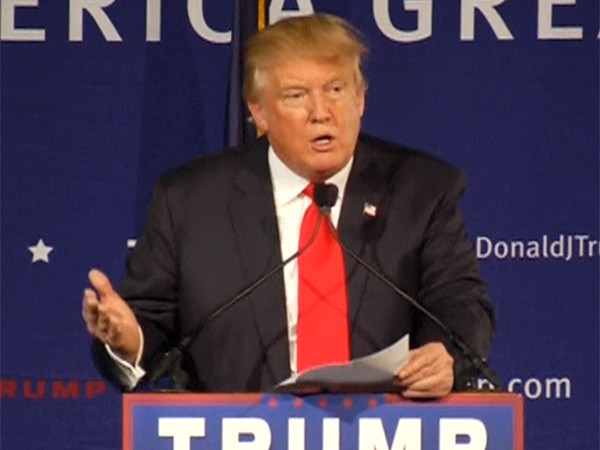
DIONNE: I would say the short answer is no. I do think that it has played a role, that the election has played a role in heightening this. And I think that the election also may have heightened fears. I think the fear is there, it’s real, it would’ve happened anyway because of Paris and San Bernardino, but political rhetoric has a way of emphasizing certain things and hope is one sentiment or virtue you hear a lot about in an election time. Fear is another.
DE SAM LAZARO: I want to talk a little bit about another issue that seems to loom so much larger today than it did a year earlier, and that is the whole issue of race in this country. Last year the talk was about it escalating in the wake of Ferguson, Missouri. There have been so many similar officer-involved incidents in the year, so many more riots that have escalated. Talk a little bit about where that issue is going, especially in the pulpits of America.
LAWTON: Well it started last year for sure, but I do think there has been a conversation going on in many congregations that perhaps has been taking place outside of the spotlight of the media, and certainly in the last part of 2015 people have been so focused on a lot of the terrorism issues, I think the race issue has not gotten as much attention, but certainly in many communities there is very great concern. And the issue is justice. And that’s what you’re hearing from the faith communities, talking about justice. And again here as well, I’m seeing even among conservative congregations concerns about racial relations. They may not agree on some of the legislative solutions in terms of policing in neighborhoods, that kind of thing, But in terms of relationships I am hearing more conversations about what does it mean to be neighbors, not just with people from maybe Syria and Iraq but people whose skin is a different color.
SOCOLOVSKY: I was down in Charleston just after the shooting at the Emanuel AME, and it was quite stunning to see so many churches of all denominations and also there was a mega church that organized a huge pray-in on the main town square there. All sorts of people, of all races, all denominations, showing solidarity and trying to understand what it is like for African-Americans today.
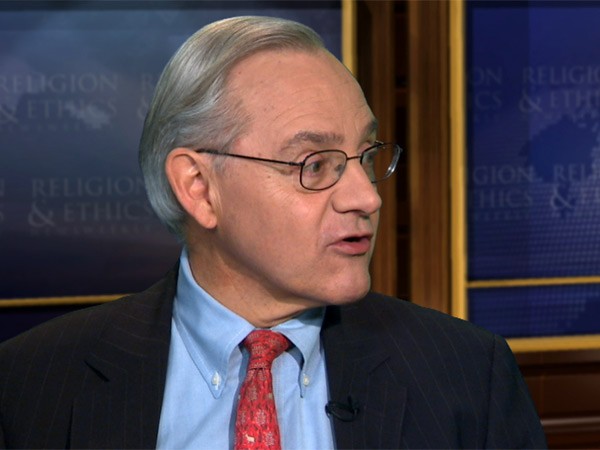
DIONNE: The reaction in that congregation to that shooting was one of the most moving moments we have seen, not only this year but in many years. And it showed the radical power of forgiveness. I mean, the Confederate flag came down in South Carolina in front of the state capital. That might’ve happened anyway because a lot of the business community there said this is not a good symbol for the future of South Carolina, but I think the response of that congregation made it inevitable that that happened. But in terms of the attention to race relations and the police, in a lot of African American neighborhoods, what people are saying is a lot of the stuff was going on before. It’s been going on for a long time. New technology, cell phones, police having to have cameras in cars or elsewhere, are really bringing to a broader audience of all races some of the abuses that the African American community has been complaining about for a long time. And I think it's made this issue present in a way it wasn’t before and set off a wave of organizing that has been very much compared to the organizing that began around the civil rights period, and I think it is a new civil rights moment.
DE SAM LAZARO: Do you sense any kind of generation gap, speaking of the involvement of churches in the civil rights movements of yesteryear, of the 1960s for example, and say, the Black Lives Matter campaigns that are in every large city in America today?
DIONNE: I think the answer is yes to that, that the old civil rights movement, the civil rights movement of the 50s and 60s, was deeply church-based. It wasn’t only church-based but the churches played an enormous role. It was the Rev. Dr. Martin Luther King. I think reflecting the fact that young Americans of all races are less attached to religion, Black Lives Matter is much more secular. That doesn’t mean there aren’t churches involved in this justice movement. Churches played an enormous role in Ferguson, for example, and in the organizing since, but I think it’s a more secular movement then the civil rights movement was.
LAWTON: Well the church in the civil rights movement of the 50s and 60s, the church was the sort of organizing tool. That was the place where people could come together. Today it’s Twitter, you know? So you don’t have the same need for a unifying place being the church. And that is one thing. And the younger people are really, in the Black Lives Matter movement, it’s a more diverse leadership. And so you don’t have those one or two strong figures leading, although there are, but it’s much more democratic in a certain respect where you have a lot less emphasis on one big person in charge. So it is a little different.
DE SAM LAZARO: I want to shift a little bit too another issue that seemed to climax with the Supreme Court verdict on same-sex marriage this year. Is this becoming a lukewarm button issue now? Is it likely to start cooling a little bit now that word has come down from on high?
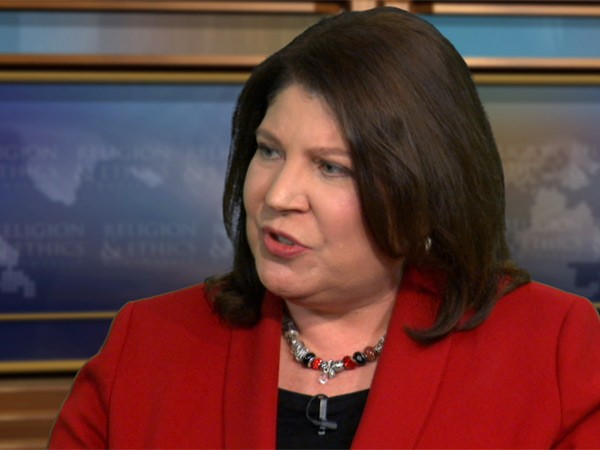
LAWTON: I don’t think the issue is cooling at all. Maybe in the streets so to speak, but inside the congregations in many places, it’s still a really difficult issue as people wrestle with this. Especially for those congregations that disagree, that really believe on a theological level that this is wrong, they’re trying to figure out how they work that out, and you do have sort of clashing culture, clashing rights. And there are also denominations that are divided within themselves still on this issue as well, in the Christian community at least. So people within the pews aren’t of one mind. Certainly there are many people of faith who think this is wonderful and are working hard for transgender issues and equality in marriage, but there are other people that are against this and how do they speak about it? How do they act it out? How do they run their ministries when they have a couples ministry in their church basement? How wide can they be, and if they don’t do that, at what point do they come up against the greater culture in ways that could bring on legal problems?
SOCOLOVSKY: It’s forcing certain conservative churches to realize that there are countercultural churches now really, especially in evangelical conservative churches, and for evangelicals it’s becoming a kind of touchstone, can we be evangelical and support same-sex marriage or support gay rights? There’s a very vigorous debate now in the evangelical world.
LAWTON: And it is really interesting because people are defining evangelicalism by their stand on same-sex marriage at a time when you also have younger evangelicals who are more supportive of it.
DIONNE: And that’s why I think you invented a great term there, "lukewarm button issue," because I don’t think this issue will be the same in the future as it has been up to now. You have a steady change in opinion on same-sex marriage. You now have a majority of Americans in favor of it, which would’ve astonished people as recently as five years ago.
DE SAM LAZARO: I want to turn to the man who said, "Who am I to judge" on this question. Pope Francis finally arrived in America, this much-anticipated visit. Talk a little bit about the impact of that visit on US polity.
LAWTON: Well, I don’t know, there was a honeymoon period where everybody was so happy to welcome the pope and be in their selfies with the Pope and all of that. Did it really effect politics? There’s still a lot of division. Did it affect the agenda that the American people, that members of Congress are talking about? I’m not sure. But he was there really emphasizing those issues that made everybody uncomfortable on the left and the right. So people on the right were uncomfortable when he talks so much about economics and immigration and climate change. But on the left they were a little uncomfortable to hear him talk about abortion and traditional marriage. So he managed to sort of make everybody a little uncomfortable, but he got so much attention. I mean, when has any pope ever gotten the coverage, including John Paul II? I mean, he really dominated America for several weeks.
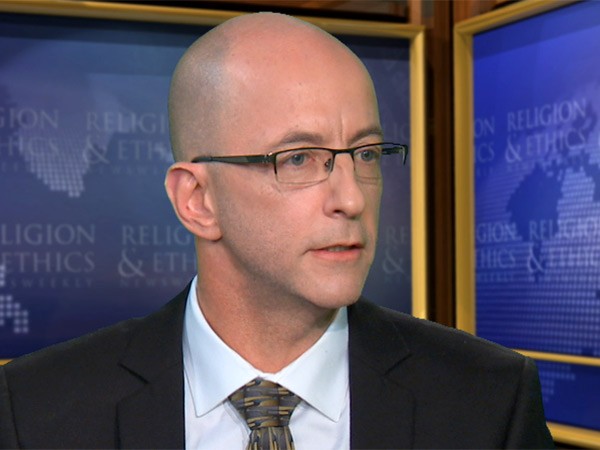
SOCOLOVSKY: Right, at a certain point, I was wondering is this a religion story or are we covering a celebrity, a rockstar?
LAWTON: Well and it was a little bit of both.
SOCOLOVSKY: Right.
DIONNE: And I thought though in terms of the balance of what he said, everyone expects a Pope to talk about abortion, and I think the balance was different with Francis and I think that was very noticeable. In his speech to Congress, he mentioned the right to life and then immediately moved to the death penalty. And I think what you’re seeing with the pope is not a change in church doctrine, but a very significant, perhaps even radical, change in emphasis. The emphasis on the poor, not only in what he said but also what he did, the kinds of people he insisted on visiting with, I think indicated a change in the church and I think in the American church you’re seeing a bit of movement in a Francis direction, where the emphasis is, you know, the Catholic church again has always talked about the poor, but I think it’s public face on this and on immigration is a much more insistent face. And the other thing that was so striking is the whole controversy over Kim Davis at the end, which really kind of changed the image of the trip, and then the Vatican quickly tried to change the image back by showing the pope embracing his former student and his partner, both of whom are gay. It was one of the oddest sort of codas to a papal trip that I think we have ever seen.
DE SAM LAZARO: Didn’t want to be stuck with the Kim Davis association as much as—
DIONNE: Right, and the Vatican insisted this was not his plan, that it was something that had been arranged for him in the Nuncio’s office.
SOCOLOVSKY: Right, it’s almost more interesting what happened after the trip and before the trip than what happened during the trip, although it was spectacular and very moving. Pope Francis before he came to the US went to three of the poorest countries in Latin America and he also made a point of going to Cuba on his way to the states, and he laid out an economic vision that did not really cohere with certainly would what we’ve been hearing from the Republicans in this country.
LAWTON: And he went to Africa after, at the end of the year, and the same thing there. Really stressed issues of justice and equality. And again, we weren’t as interested, as the US, in those trips. But again, very interesting.
DIONNE: And the role the Vatican played in normalizing relations between the United States and Cuba gave President Obama, if he needed it, I’m not sure he does anymore, but needed some cover because if the Vatican blesses this, it’s much harder to oppose making peace with one of the last remaining communist regimes in the world.
DE SAM LAZARO: Well, I'm afraid we're pretty much out of time. Great discussion, lots of stories that we did not touch on. I was particularly intrigued by the one that you did about the women’s mosque, and the women-led mosque, in Los Angeles, which is so unusual because the narrative about Islam has always to do with security, terrorism, et cetera, but...
LAWTON: Yeah, well, there’s a lot of issues about women and religion we'll talk about next year too, I’m sure.
DE SAM LAZARO: Thanks. Kim Lawton, Jerome Socolovsky, E.J. Dionne, thank you very much.
DIONNE: Great to be with you.
SOCOLOVSKY: Likewise.









